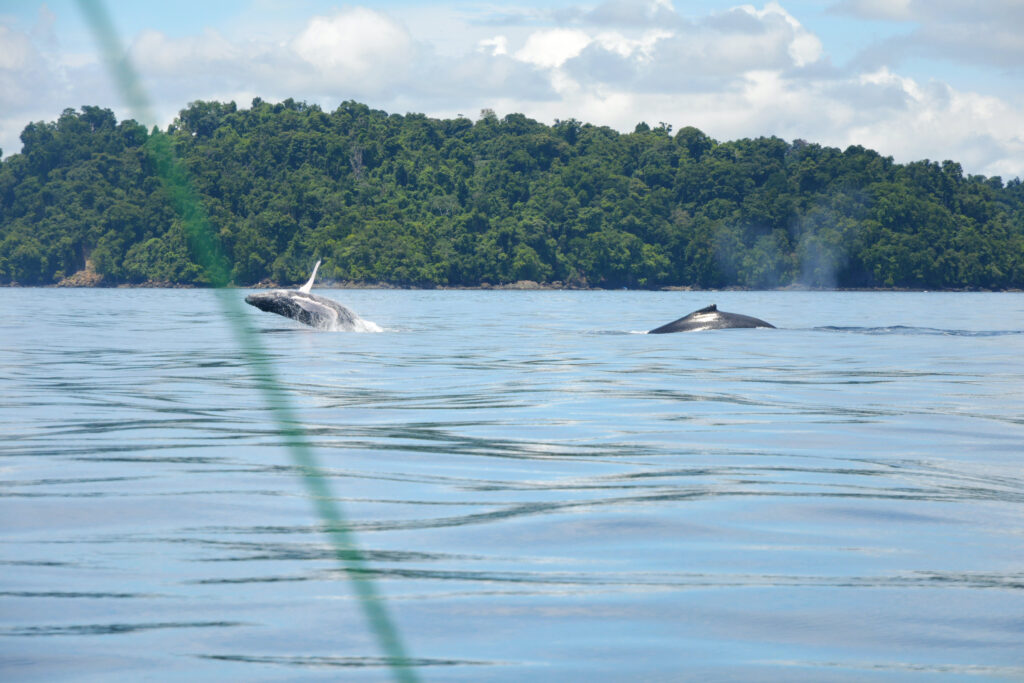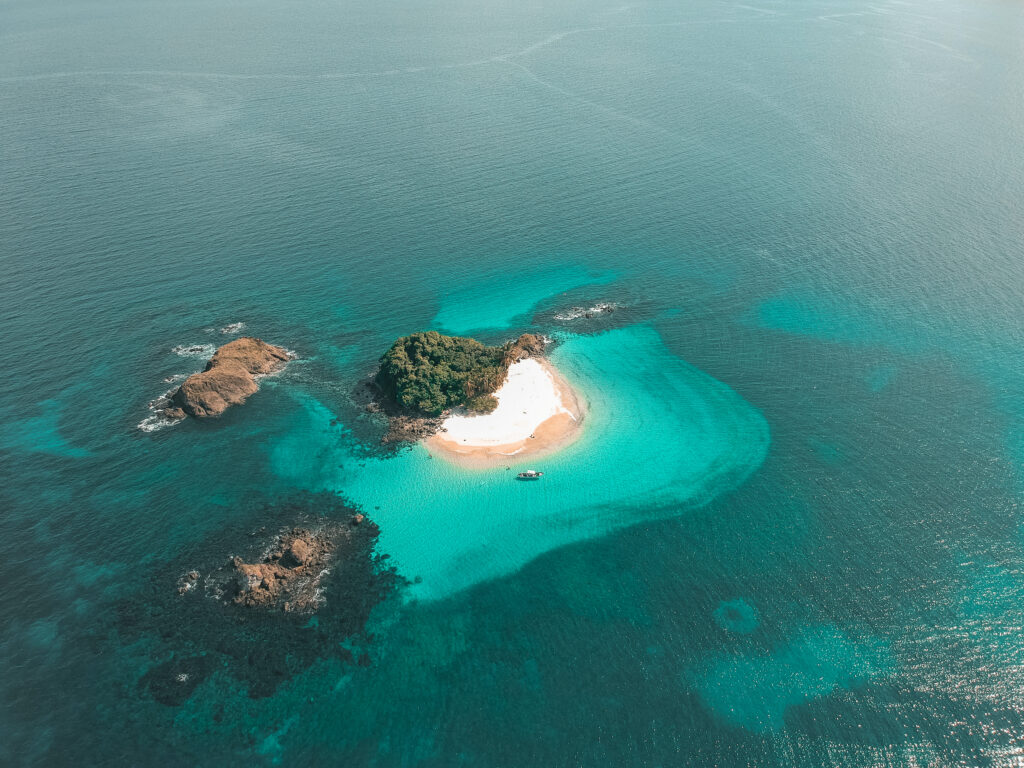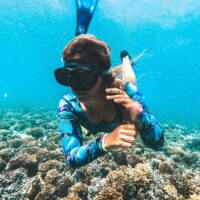Known for being the largest island in the Central American Pacific, Coiba is a wild and hidden paradise located next to Santa Catalina, a town in the Veraguas province of Panama. With white sand beaches and warm turquoise waters, this island is teeming with marine life making it an ideal spot for diving enthusiasts. Diving with sharks and manta rays, watching whales and dolphins from the boat, swimming with sea turtles and school of multicolored fish – these are just a few of the incredible ocean adventures you can experience here.
We were floating in the middle of Panama’s Pacific Ocean in a ‘panga‘, a small boat, when suddenly one of the people on board pointed and shouted excitedly, “Whale!” The captain stopped the boat dead in its tracks. Slowly we advanced towards the big blue horizon in silence and somewhat nervously, trying to turn on our cameras in time. We could see a large dark shape a few meters away but it quickly disappeared. Suddenly we heard a loud noise in the water as a whale jumped up and to the side, landing right in front of us. Our jaws dropped. We huddled on the end of the boat to get a closer look. This natural spectacle was repeated about three times as we watched up close, as if we were part of a nature documentary. But it wasn’t a movie, it was real life; we were in Coiba and this dive trip had only just begun.

Newly Expanded Cordillera de Coiba Marine Protected Area
Coiba is one of the most important protected areas in Panama. In 2005 it was named a World Heritage site by UNESCO (United Nations Educational, Scientific and Cultural Organization) due to its great biodiversity, its varied ecosystems and for having unique species in the world. The marine magic of this place is due to the fact that it is part of the Eastern Tropical Pacific Marine Corridor (CMAR). This means that marine animals that come from dreamy places like the Galapagos Islands in Ecuador and the Cocos Island in Costa Rica travel through the waters along the channel.
On June 8th, 2021 (World Oceans Day), the President and Minister of Environment of Panama signed a decree that protects the Coiba Ridge, a move that will triple the Cordillera de Coiba marine protected area – an area of nearly 68,000 km2. With this act, Panama is set to be ahead of the 30% by 2030 goals (30×30) and become a true Blue Leader – a country that officially ‘highly and fully’ protects 30% or more of its oceans. Of the newly expanded MPA, 2/3rds are designated as no-take, while the remaining ⅓ is planned for sustainable use, with no industrial fishing allowed. Learn more via Mission Blue’s press release.
Dr. Sylvia Earle, Founder of Mission Blue, says, “Congratulations to President Laurentino Cortizo and the country of Panama for protecting this special part of the blue planet. I hope this inspiring commitment gives courage to neighboring countries in the region including Costa Rica, Colombia and Ecuador to take similar actions to protect the incredible biodiversity in their waters, to link up protections and create a corridor where wildlife can thrive.”

Top Dive Sites Around Coiba
The dives here usually have active current and are quite deep. We recommend earning your PADI Advanced Open Water Diver, and possibly your PADI Deep Diver certifications before you go. There are more than 32 spectacular dive sites surrounding Coiba, but here are 8 of my favorites:
Buffet:
This dive site’s name is derived from the ‘buffet’ of fish that you can see here. When there is a lot of current you can also see white tip sharks hunting jacks and, if you’re lucky, whale sharks too during the right season.
Wahoo Rock:
Here you also have a good chance of seeing whale sharks and manta rays in season since plankton are always well distributed at this dive site.
El Faro:
This is a deep dive site and there is usually quite a lot of current. You can enjoy the colorful corals and white tip sharks at the start and then at about 30 meters deep when the water is cold you can see hammerhead sharks.
Iglesia:
This is a calm dive with less current and lots of colors. Here you can find turtles, seahorses and frogfish.
Contreras:
A little further away from the main island, this area consists of a group of islands to the north. The dives in this area are deep, open ocean dives. The most popular dive sites within Contreras are:
- Montaña Rusa: The Spanish name for ‘roller coaster’, this site is known for its strong current which, according to the locals, turns the underwater experience into a roller coaster of emotions. Here there are usually eagle rays and southern stingrays and you always have to be aware of what is going on around you because you don’t know when you just might see something amazing.
- Sombrero de Pelo: Diving this site generates quite a bit of adrenaline because you have to descend with negative buoyancy. If you go in April, which is hammerhead shark migration season, you will surely see these wonderful giants.
- Punta Peligro: This site is popular because many bull sharks have been seen here.

Explore Above and Below the Surface
With more than 1000 species of plants, Coiba is also a perfect place for those interested in botany. This tropical garden is also home to a crocodile that the locals call ‘Tito’, who they protect and treat with great respect. Around the island of Coiba there are 38 small uninhabited islands that can be easily explored. One of them is ‘Granito de Oro’, named after the golden color of the sand. There, we snorkeled amongst its colorful corals. Its waters are so clear that we did not mind swimming until exhaustion as we swam around the whole island itself. In addition to fish, we saw white tip sharks and sea turtles. Rancheria, also known as ‘Coibita’, was another island where we spent our daytime excursions amongst palm trees, monkeys and coconuts.
Getting to observe and enjoy all these extraordinary marine animals and unique nature made me wonder why we don’t hear about Coiba more often. The reason why this place has not been frequented much in recent years is because it has a dark past. There used to be a penitentiary where terrible crimes were committed during Panama’s dictatorship. This somber past made it difficult for Coiba to be associated with an uplifting tourist destination. Today you can visit the ruins of the prison, learn about its history and become aware of the past. Ironically, this element of Coiba’s past enables tourism for the island to grow, for people to travel to enjoy this true ecological adventure in its completeness.
To travel to Coiba is to explore the planet up close. To arrive at this bountiful destination, you have to be prepared to get wet and muddy, to learn and to explore. Heels and nice clothes are left at home while bathing suits and dive gear should fill your suitcases. The lack of wifi in the area invites you to fully connect with nature and forget the fast pace of the city. During this adventure I witnessed the immensity of the ocean and the depth of wildlife – collecting stories and moments that I had only seen before in movies. Coiba is an ideal destination to remember that we don’t need technology to survive, nor do we need great luxuries to have great times!

Article written by Martina Alvarez @oceanomartina – Environmental Journalist & Scuba Diving Instructor.



